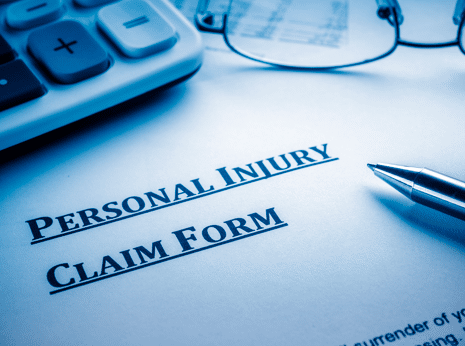* The following article – How long Does a Personal Injury Lawsuit Take? – contains legal information for a general audience, is provided for informational purposes only, and should not be taken as legal advice or legal opinions. For legal advice, always consult with an attorney. *
So you’ve been injured and are now seeking compensation for your injuries in the form of a personal injury lawsuit. How long can you expect the process to take before you actually see your compensation paid out?
This question can be a tricky one due to the nature of personal injury claims, as there really isn’t a single umbrella answer to the question at hand. Each case is affected by different facts and conditions that make it unique.
Let’s take a look at the personal injury lawsuit process and some of the factors that may play a role in either expediting or prolonging a personal injury claim.
The Personal Injury Claim Process

As we’ve already stated, a personal injury lawsuit time frame can vary to a significant degree. However, personal injury claims generally follow a fairly standard process from inception until a decision is made on the claim.
In general, the personal injury claim process goes as follows
- Hiring a Personal Injury Attorney – Due to the complex nature of personal injury claims, the recommended step in the process is hiring a personal injury attorney equipped to deal with the complexities of your case.
- Medical care – The injured victim usually has medical/health care to address and usually to treat the injuries and conditions caused by the accident or incident.
- Settlement Negotiations – Interestingly enough, the majority of claims never make it to trial and are settled out of court. This is another reason why consulting an experienced personal injury attorney is a crucial first step in the process. Settlement negotiations usually occur once the injured party’s medical care from the accident has concluded – this can sometimes take months, and depending on the case, a year or more.
Many or most cases conclude through settlement agreement reached through negotiations, without the need of a lawsuit, meaning steps 4 – 7 (below) are not needed.
- Lawsuit filing – If the at-fault party’s insurer and the injured victim (usually best represented by an experienced attorney) can’t reach an agreement on compensation, the victim’s attorney would typically then file a lawsuit in court. The lawsuit would ask the court’s judge or jury to make an official, independent decision on who is at fault, and on what amount of money compensation may be due to the victim.
- Discovery – Discovery is a term used to refer to the initial information-gathering phase of a lawsuit. Both parties are required to share any information related to the claim. Courts usually declare a specific timeline when both sides can fairly learn about the other side’s evidence, about any witnesses, including expert witnesses, such as the victim’s physicians.
- Trial – If a settlement cannot be reached after discovery, the lawsuit goes to trial. Depending on the type of injuries, and the particular court, the discovery process can be lengthy, anywhere from several months to sometimes more than a year, as insurance companies often do not agree on liability or question the severity of injury or the victim’s medical care.
- Verdict and Appeals – Finally a verdict is read, and the process is over. Or so you thought. Even once a decision is made, both parties reserve the right to appeal a decision that they feel is unjust. This is another reason why a personal injury lawsuit has the potential to span over the course of several months, if not years.
As you can see, the process can be a complex and arduous one. In general, the average time for a personal injury claim and lawsuit takes anywhere from about 4 months to 3 years, depending on a number of case-specific factors. We get that might not be the answer you’re looking for, but with the complexity of these cases, there is no set time frame for resolution. Having an attorney who knows how to best navigate these situations to your advantage is important.
Factors Influencing How Long a Personal Injury Lawsuit Takes
With a general time frame being established, we should note that there are a few factors that could ultimately prolong the length of your claim and when necessary, lawsuit.
Some of the most common scenarios in which a personal injury claim or lawsuit decision may be delayed are:
Insurance Company Dispute Delays
At times, insurance adjusters might perceive that prolonging your case aligns with the company’s interests. Particularly when the three-year Statute of Limitations deadline (more on this later) is rapidly approaching and a claimant has not yet initiated legal proceedings, the insurance company may adopt a strategy of delay, banking on the possibility that the claimant’s case will run out of time.
Even when a lawsuit has been formally filed, insurance companies often employ delaying tactics. An adjuster may discern that the victim is facing financial difficulties and cannot afford to wait for an extended period for a potential trial. These delaying maneuvers may encompass tactics such as misplacing correspondence or reshuffling adjusters. The insurance company’s underlying assumption may be that the victim will become frustrated, both physically and mentally, and possibly abandon the case.
Severity of Injuries Suffered
Ongoing medical treatment can significantly extend the duration of a claim. Many insurance companies refrain from engaging in claim discussions and settlement discussions/negotiations until your treatment concludes, or until you reach a state of maximum medical improvement. Unfortunately, some individuals may never fully recover from their injuries, especially if they experience severe conditions.
In such cases, your doctor may need to work with your attorney to reach an appropriate sum for future medical care, as well as the cost of current and past treatment. Often, insurance companies will dispute such large claims, bringing in medical professionals who may attempt to negate the severity of your condition and overall claim.
Determining Liability
As with the nature of nearly all personal injury lawsuits, determining liability lies at the forefront of the claim.
Determining who is actually at fault is often the most time-consuming part of any personal injury lawsuit. Due to the contributory negligence rules in Maryland, it’s in the opposing party’s interest to claim that you were at least partially at fault for the injury. This can include requesting medical records, witness interviews, and dashcam footage, all of which take time to procure.
As we’ve stated, insurance companies are likely to attempt to shift liability, particularly with cases for the potential of a high payout.
Maryland Statue of Limitations

A statute of limitations, a longstanding legal concept dating back to ancient times, is a law establishing a finite timeframe within which lawsuits and legal actions must be initiated.
These statutes serve the fundamental purpose of preventing unfair prosecution or penalties against defendants. The rationale behind them is to prevent situations where wrongdoers, whether in criminal or civil cases, could be held accountable indefinitely. Such open-ended accountability could result in the loss of pertinent evidence and the potential unavailability of witnesses due to factors like death, disappearance, or fading memories, ultimately leading to unjust legal proceedings.
While certain grave offenses like murder or sexual crimes have no statute of limitations in select jurisdictions due to their severity, civil matters, particularly those involving personal injury or property damage, invariably fall under the purview of the statute of limitations regulations. In the context of Maryland, the statute of limitations for typical claims where a person is injured in an accident, is three years, meaning there is a three-year window within which to resolve an insurance claim or file a lawsuit.
Depending on the type and circumstances of the case – there may be other deadlines that can expire much faster than the statute of limitations, permanently limiting or ending a victim’s ability to obtain certain types of compensation.
Therefore, it is almost always best to work with a knowledgeable attorney as soon as reasonably possible after an injury to protect your rights.
Hire a Maryland Personal Injury Attorney Today
When it comes to personal injury claims, the journey can be intricate and overwhelming, demanding a high level of legal proficiency, expertise, and adeptness. Fortunately, you don’t need to navigate this path solo.
In moments of adversity, you deserve unwavering support and the confidence that justice will prevail. At Jezic and Moyse, we proudly stand as a distinguished personal injury firm in Maryland. We truly understand the profound ramifications personal injuries can impose – encompassing physical, emotional, and financial aspects. Our experienced trial attorneys are wholeheartedly dedicated to ensuring you receive the full compensation you’re entitled to under the law.
With an unswerving commitment to transparency and a relentless pursuit of excellence, we extend an invitation for a complimentary initial consultation. During this session, we provide an upfront and experienced evaluation of your case and the factors affecting its potential worth, coupled with a clearly charted path toward achieving the most favorable outcome. By placing your personal injury case in our capable hands, you regain the freedom to concentrate on your recovery and the restoration of normalcy in your life.
Our accomplished history underscores our unwavering commitment to delivering tangible results. We urge you to explore our past accomplishments in managing personal injury cases. When you opt for Jezic and Moyse, you’re not merely choosing legal representation; you’re forging an unwavering partnership in your quest for justice.
Commence your journey toward securing the compensation and resolution you rightfully deserve by scheduling your cost-free consultation today!
